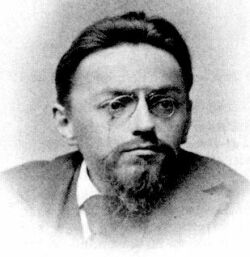<Back to Index>
- Engineer Charles Proteus Steinmetz, 1865
- Poet Charles Pierre Baudelaire, 1821
- Prime Minister of France André Léon Blum, 1872

Charles Proteus Steinmetz (April 9, 1865 – October 26, 1923) was a German-American mathematician and electrical engineer. He fostered the development of alternating current that made possible the expansion of the electric power industry in the United States, formulating mathematical theories for engineers. He made ground-breaking discoveries in the understanding of hysteresis that enabled engineers to design better electric motors for use in industry.
Steinmetz was born as Carl August Rudolph Steinmetz to Carl Heinrich Steinmetz in Breslau, Province of Silesia. Steinmetz suffered from dwarfism, hunchback, and hip dysplasia, as did his father and grandfather. Steinmetz attended Johannes Gymnasium and astonished his teachers with his proficiency in mathematics and physics. Following the Gymnasium Steinmetz went on to the University of Breslau to begin work on his undergraduate degree in 1883. He was on the verge of finishing his Doctorate in 1888 when he came under investigation by the German police for activities on behalf of a socialist university group and articles he had written for a local socialist newspaper. As socialist meetings and press had been banned in Germany, Steinmetz fled toZürich in 1888 to escape possible arrest. Faced with an expiring visa, he emigrated to the United States in 1889.
Cornell University Professor Ronald R. Kline, the author of Steinmetz: Engineer and Socialist, contends that other factors were more directly involved in Steinmetz's decision to leave his homeland, such as the fact that he was in arrears with his tuition at the University of Breslau and that life at home with his father, stepmother, and their daughters was full of tension.
Despite his earlier efforts and interest in socialism, by 1922 Steinmetz concluded that socialism would never work in the United States because the country lacked a "powerful, centralized government of competent men, remaining continuously in office" and because "only a small percentage of Americans accept this viewpoint today."
Shortly after arriving in the US, Steinmetz went to work for Rudolf Eickemeyer in Yonkers, New York, and published in the field of magnetic hysteresis. Eickemeyer's firm developed transformers for use in the transmission of electrical power
among many other mechanical and electrical devices. In 1893
Eickemeyer's company, along with all of his patents and designs, was
bought by the newly formed General Electric Company. At
the International Electrical Congress in Chicago that year Steinmetz
made one of his greatest contributions to the Electrical Engineering
community, a lecture and presentation describing the mathematics of alternating current phenomena which had not previously been explained by earlier engineers. Steinmetz used the term phasor for
his simplified mathematical representation of an electricity waveform,
a property that has greatly simplified the analysis of AC circuits.
Since the 1990s, phasor measurement units have
been used to measure the health of wide area electrical networks, and
are currently revolutionizing the power industry worldwide. Use
of Steinmetz's innovations in the mathematics of electricity enabled
engineers to move from designing electric motors by trial and error to
designing them with the aid of applicable mathematics to create on
paper the best possible motor before actually constructing it. In 1894,
General Electric moved to Schenectady, New York,
and Steinmetz was promoted to head of the calculating department, where
his colleagues would bring to him the mathematical problems that were
stumbling blocks to their projects. When not freely helping his
co-workers, he worked on his own experiments in electricity and served
first as chairman of the Department of Electrical Engineering and later
as a part-time professor at Union College between 1902 to 1923.
One
of Steinmetz's great research projects was centered with the phenomena
of lightning. He undertook a systematic study of it, resulting in
experiments of man-made lightning in the laboratory; this work was
published. Steinmetz was called the "forger of thunderbolts", being the
first to create artificial lightning in his GE football field-sized
laboratory and high towers, using 120,000 volt generators. He
also erected a lightning tower to attract lightning and studied the
patterns and effects of lightning hits on tree bark and in a broken
mirror—resulting in several theories and ideas (like the effect of
lightning on plant growth and ac electric poles). Steinmetz served as president of the Board of Education of Schenectady, and as president of the Schenectady city council. He was also president of the American Institute of Electrical Engineers (AIEE)
from 1901 to 1902, as well as the first vice-president of the
International Association of Municipal Electricians (IAME)—which later
became the International Municipal Signal Association (IMSA) — from
1913 until his death. Steinmetz wrote 13 books and 60 articles, not all
about science. He was an honorary member and advisor to the fraternity Phi Gamma Delta at Union (whose chapter house there was one of the first electrified houses ever). Steinmetz died on October 26, 1923 and was buried in Vale Cemetery, Schenectady. His connection to Union College is celebrated with the annual Steinmetz Symposium, a day-long event in which Union undergraduates give presentations on research they have done. Steinmetz Hall, which houses the Union College computer center, is named after him.